Comprehensive Report on Business Contracts and Negligence
VerifiedAdded on 2019/12/04
|17
|5963
|67
Report
AI Summary
This report provides a detailed overview of contracts and negligence within a business context. It begins by defining contracts, outlining essential elements such as offer and acceptance, consideration, free consent, and lawful object, with references to relevant case law like Carlill v Carbolic Smoke Ball Co. and Currie v Misa. The report then classifies different contract types, including unilateral, bilateral, simple, deed, verbal, written, face-to-face, and distance selling contracts, highlighting their key features and legal implications. It also explores contractual terms, differentiating between express and implied terms, conditions, warranties, innominate terms, and exclusion clauses, supported by case examples such as Hutton v Warren and Bettini v Gye. Furthermore, the report analyzes two scenarios involving contract formation and breach, applying legal principles to evaluate the enforceability of agreements, addressing issues like invitation to treat, offer, acceptance, and exclusion clauses, and providing insights into potential legal outcomes. It also delves into the concept of negligence, explaining its elements and demonstrating its application to business contexts.
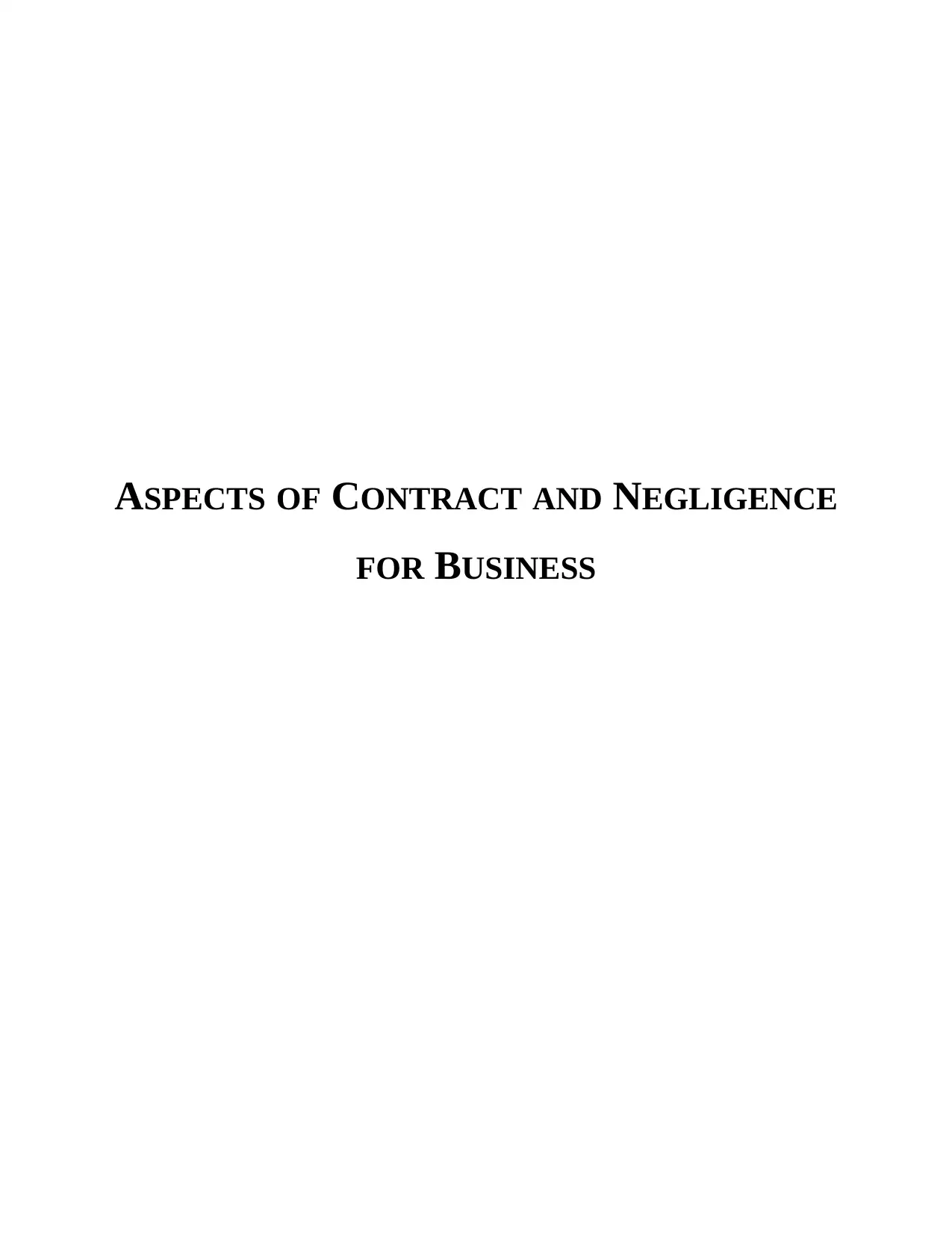
ASPECTS OF CONTRACT AND NEGLIGENCE
FOR BUSINESS
FOR BUSINESS
Paraphrase This Document
Need a fresh take? Get an instant paraphrase of this document with our AI Paraphraser
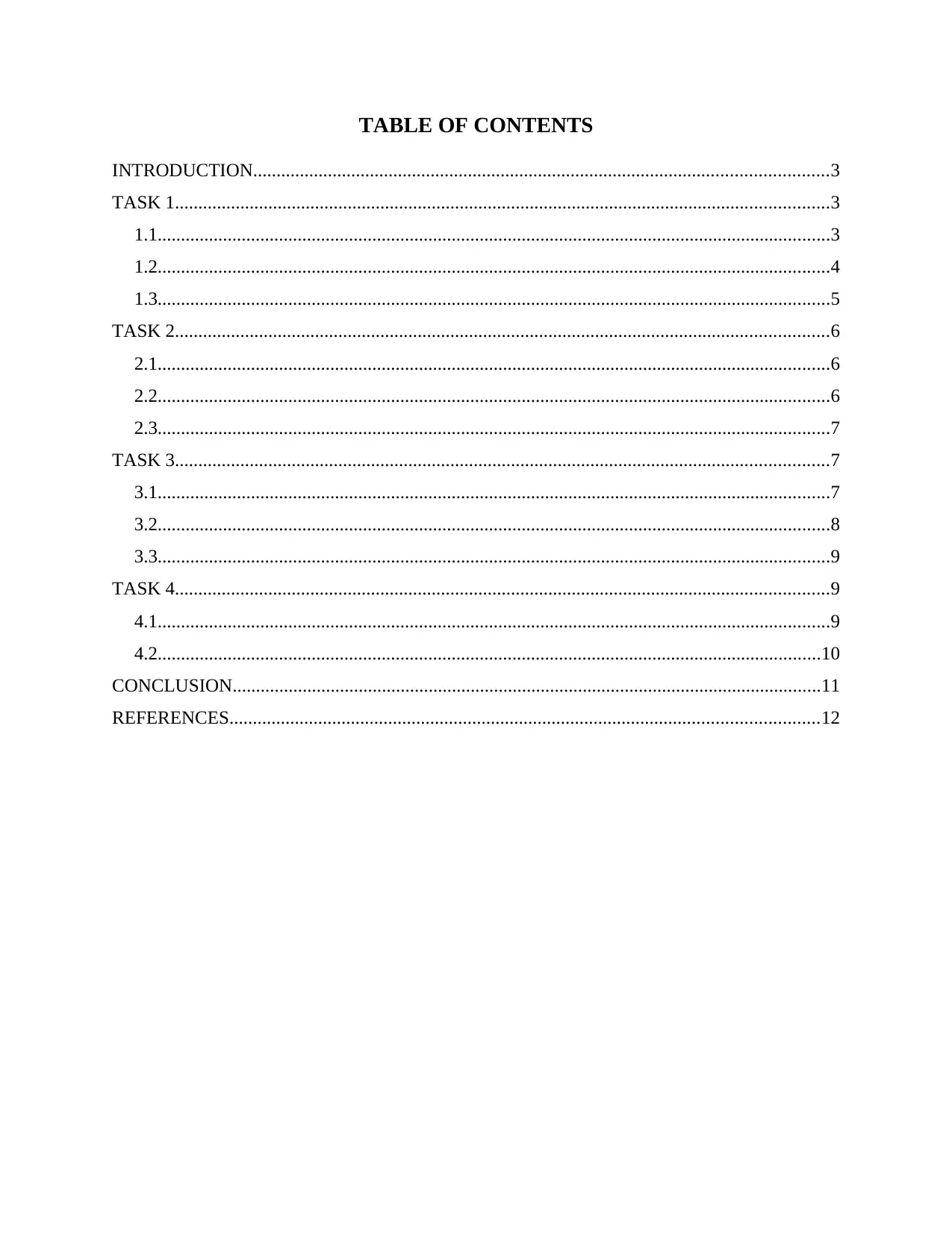
TABLE OF CONTENTS
INTRODUCTION...........................................................................................................................3
TASK 1............................................................................................................................................3
1.1................................................................................................................................................3
1.2................................................................................................................................................4
1.3................................................................................................................................................5
TASK 2............................................................................................................................................6
2.1................................................................................................................................................6
2.2................................................................................................................................................6
2.3................................................................................................................................................7
TASK 3............................................................................................................................................7
3.1................................................................................................................................................7
3.2................................................................................................................................................8
3.3................................................................................................................................................9
TASK 4............................................................................................................................................9
4.1................................................................................................................................................9
4.2..............................................................................................................................................10
CONCLUSION..............................................................................................................................11
REFERENCES..............................................................................................................................12
INTRODUCTION...........................................................................................................................3
TASK 1............................................................................................................................................3
1.1................................................................................................................................................3
1.2................................................................................................................................................4
1.3................................................................................................................................................5
TASK 2............................................................................................................................................6
2.1................................................................................................................................................6
2.2................................................................................................................................................6
2.3................................................................................................................................................7
TASK 3............................................................................................................................................7
3.1................................................................................................................................................7
3.2................................................................................................................................................8
3.3................................................................................................................................................9
TASK 4............................................................................................................................................9
4.1................................................................................................................................................9
4.2..............................................................................................................................................10
CONCLUSION..............................................................................................................................11
REFERENCES..............................................................................................................................12
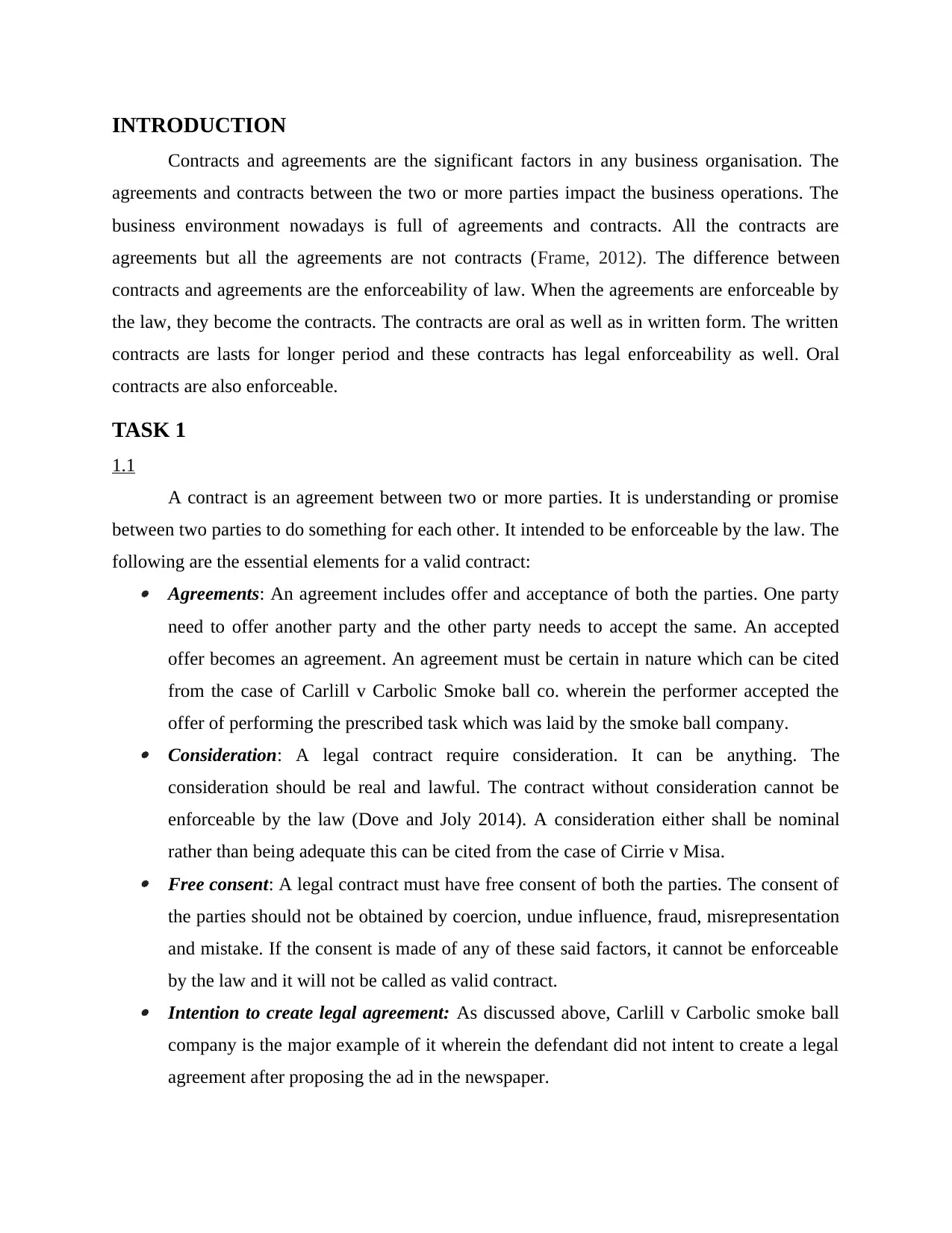
INTRODUCTION
Contracts and agreements are the significant factors in any business organisation. The
agreements and contracts between the two or more parties impact the business operations. The
business environment nowadays is full of agreements and contracts. All the contracts are
agreements but all the agreements are not contracts (Frame, 2012). The difference between
contracts and agreements are the enforceability of law. When the agreements are enforceable by
the law, they become the contracts. The contracts are oral as well as in written form. The written
contracts are lasts for longer period and these contracts has legal enforceability as well. Oral
contracts are also enforceable.
TASK 1
1.1
A contract is an agreement between two or more parties. It is understanding or promise
between two parties to do something for each other. It intended to be enforceable by the law. The
following are the essential elements for a valid contract: Agreements: An agreement includes offer and acceptance of both the parties. One party
need to offer another party and the other party needs to accept the same. An accepted
offer becomes an agreement. An agreement must be certain in nature which can be cited
from the case of Carlill v Carbolic Smoke ball co. wherein the performer accepted the
offer of performing the prescribed task which was laid by the smoke ball company. Consideration: A legal contract require consideration. It can be anything. The
consideration should be real and lawful. The contract without consideration cannot be
enforceable by the law (Dove and Joly 2014). A consideration either shall be nominal
rather than being adequate this can be cited from the case of Cirrie v Misa. Free consent: A legal contract must have free consent of both the parties. The consent of
the parties should not be obtained by coercion, undue influence, fraud, misrepresentation
and mistake. If the consent is made of any of these said factors, it cannot be enforceable
by the law and it will not be called as valid contract. Intention to create legal agreement: As discussed above, Carlill v Carbolic smoke ball
company is the major example of it wherein the defendant did not intent to create a legal
agreement after proposing the ad in the newspaper.
Contracts and agreements are the significant factors in any business organisation. The
agreements and contracts between the two or more parties impact the business operations. The
business environment nowadays is full of agreements and contracts. All the contracts are
agreements but all the agreements are not contracts (Frame, 2012). The difference between
contracts and agreements are the enforceability of law. When the agreements are enforceable by
the law, they become the contracts. The contracts are oral as well as in written form. The written
contracts are lasts for longer period and these contracts has legal enforceability as well. Oral
contracts are also enforceable.
TASK 1
1.1
A contract is an agreement between two or more parties. It is understanding or promise
between two parties to do something for each other. It intended to be enforceable by the law. The
following are the essential elements for a valid contract: Agreements: An agreement includes offer and acceptance of both the parties. One party
need to offer another party and the other party needs to accept the same. An accepted
offer becomes an agreement. An agreement must be certain in nature which can be cited
from the case of Carlill v Carbolic Smoke ball co. wherein the performer accepted the
offer of performing the prescribed task which was laid by the smoke ball company. Consideration: A legal contract require consideration. It can be anything. The
consideration should be real and lawful. The contract without consideration cannot be
enforceable by the law (Dove and Joly 2014). A consideration either shall be nominal
rather than being adequate this can be cited from the case of Cirrie v Misa. Free consent: A legal contract must have free consent of both the parties. The consent of
the parties should not be obtained by coercion, undue influence, fraud, misrepresentation
and mistake. If the consent is made of any of these said factors, it cannot be enforceable
by the law and it will not be called as valid contract. Intention to create legal agreement: As discussed above, Carlill v Carbolic smoke ball
company is the major example of it wherein the defendant did not intent to create a legal
agreement after proposing the ad in the newspaper.
⊘ This is a preview!⊘
Do you want full access?
Subscribe today to unlock all pages.

Trusted by 1+ million students worldwide
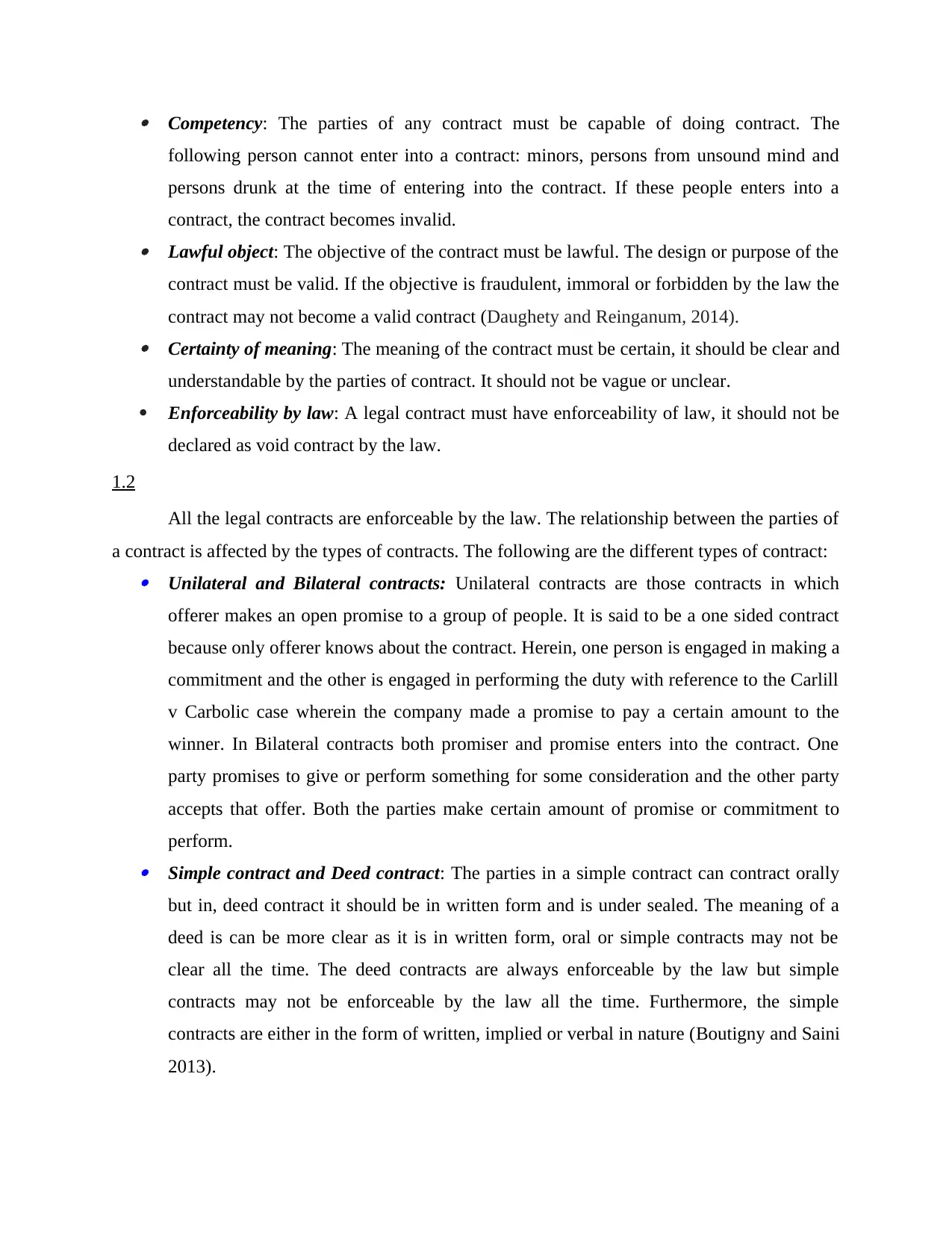
Competency: The parties of any contract must be capable of doing contract. The
following person cannot enter into a contract: minors, persons from unsound mind and
persons drunk at the time of entering into the contract. If these people enters into a
contract, the contract becomes invalid. Lawful object: The objective of the contract must be lawful. The design or purpose of the
contract must be valid. If the objective is fraudulent, immoral or forbidden by the law the
contract may not become a valid contract (Daughety and Reinganum, 2014). Certainty of meaning: The meaning of the contract must be certain, it should be clear and
understandable by the parties of contract. It should not be vague or unclear.
Enforceability by law: A legal contract must have enforceability of law, it should not be
declared as void contract by the law.
1.2
All the legal contracts are enforceable by the law. The relationship between the parties of
a contract is affected by the types of contracts. The following are the different types of contract: Unilateral and Bilateral contracts: Unilateral contracts are those contracts in which
offerer makes an open promise to a group of people. It is said to be a one sided contract
because only offerer knows about the contract. Herein, one person is engaged in making a
commitment and the other is engaged in performing the duty with reference to the Carlill
v Carbolic case wherein the company made a promise to pay a certain amount to the
winner. In Bilateral contracts both promiser and promise enters into the contract. One
party promises to give or perform something for some consideration and the other party
accepts that offer. Both the parties make certain amount of promise or commitment to
perform. Simple contract and Deed contract: The parties in a simple contract can contract orally
but in, deed contract it should be in written form and is under sealed. The meaning of a
deed is can be more clear as it is in written form, oral or simple contracts may not be
clear all the time. The deed contracts are always enforceable by the law but simple
contracts may not be enforceable by the law all the time. Furthermore, the simple
contracts are either in the form of written, implied or verbal in nature (Boutigny and Saini
2013).
following person cannot enter into a contract: minors, persons from unsound mind and
persons drunk at the time of entering into the contract. If these people enters into a
contract, the contract becomes invalid. Lawful object: The objective of the contract must be lawful. The design or purpose of the
contract must be valid. If the objective is fraudulent, immoral or forbidden by the law the
contract may not become a valid contract (Daughety and Reinganum, 2014). Certainty of meaning: The meaning of the contract must be certain, it should be clear and
understandable by the parties of contract. It should not be vague or unclear.
Enforceability by law: A legal contract must have enforceability of law, it should not be
declared as void contract by the law.
1.2
All the legal contracts are enforceable by the law. The relationship between the parties of
a contract is affected by the types of contracts. The following are the different types of contract: Unilateral and Bilateral contracts: Unilateral contracts are those contracts in which
offerer makes an open promise to a group of people. It is said to be a one sided contract
because only offerer knows about the contract. Herein, one person is engaged in making a
commitment and the other is engaged in performing the duty with reference to the Carlill
v Carbolic case wherein the company made a promise to pay a certain amount to the
winner. In Bilateral contracts both promiser and promise enters into the contract. One
party promises to give or perform something for some consideration and the other party
accepts that offer. Both the parties make certain amount of promise or commitment to
perform. Simple contract and Deed contract: The parties in a simple contract can contract orally
but in, deed contract it should be in written form and is under sealed. The meaning of a
deed is can be more clear as it is in written form, oral or simple contracts may not be
clear all the time. The deed contracts are always enforceable by the law but simple
contracts may not be enforceable by the law all the time. Furthermore, the simple
contracts are either in the form of written, implied or verbal in nature (Boutigny and Saini
2013).
Paraphrase This Document
Need a fresh take? Get an instant paraphrase of this document with our AI Paraphraser
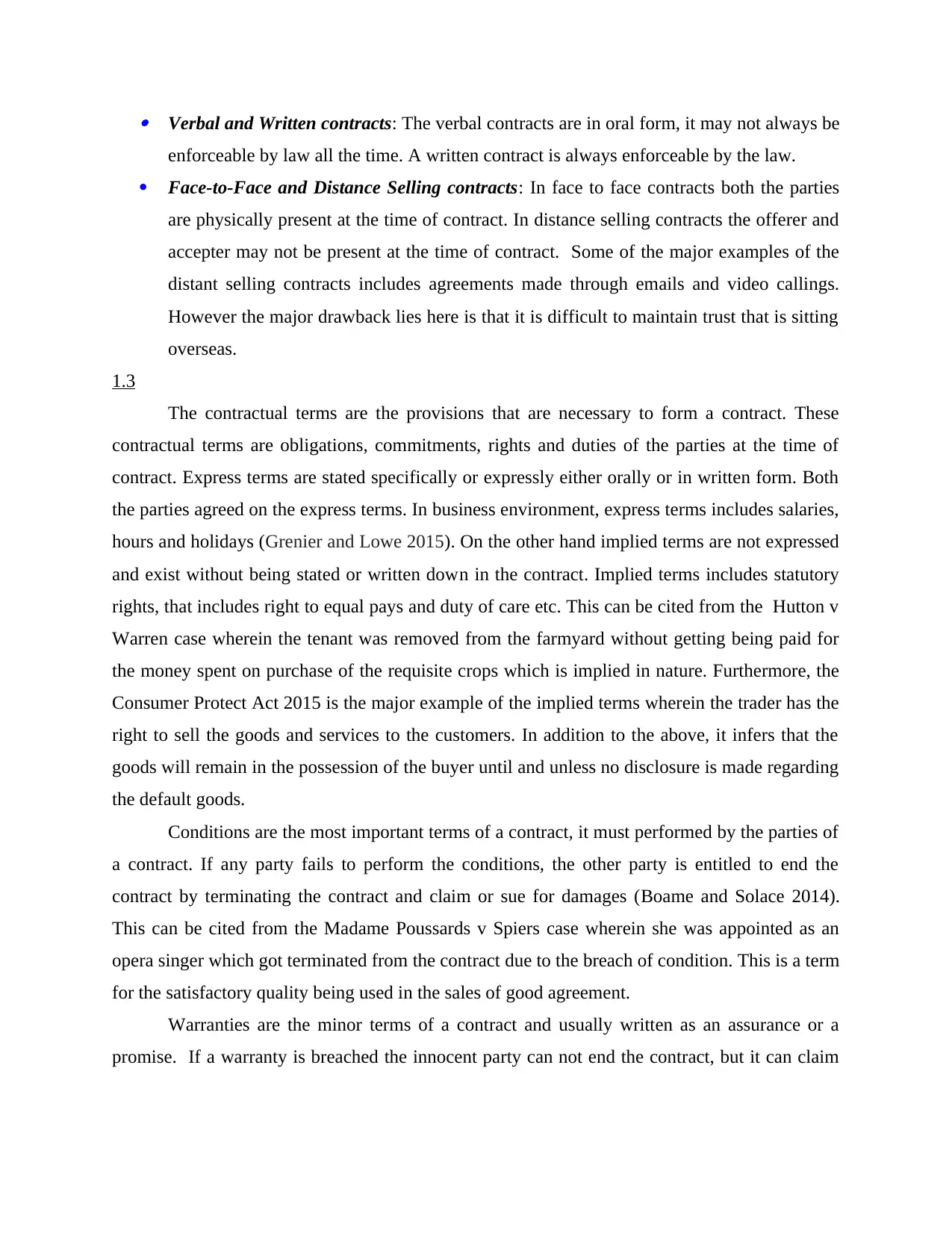
Verbal and Written contracts: The verbal contracts are in oral form, it may not always be
enforceable by law all the time. A written contract is always enforceable by the law.
Face-to-Face and Distance Selling contracts: In face to face contracts both the parties
are physically present at the time of contract. In distance selling contracts the offerer and
accepter may not be present at the time of contract. Some of the major examples of the
distant selling contracts includes agreements made through emails and video callings.
However the major drawback lies here is that it is difficult to maintain trust that is sitting
overseas.
1.3
The contractual terms are the provisions that are necessary to form a contract. These
contractual terms are obligations, commitments, rights and duties of the parties at the time of
contract. Express terms are stated specifically or expressly either orally or in written form. Both
the parties agreed on the express terms. In business environment, express terms includes salaries,
hours and holidays (Grenier and Lowe 2015). On the other hand implied terms are not expressed
and exist without being stated or written down in the contract. Implied terms includes statutory
rights, that includes right to equal pays and duty of care etc. This can be cited from the Hutton v
Warren case wherein the tenant was removed from the farmyard without getting being paid for
the money spent on purchase of the requisite crops which is implied in nature. Furthermore, the
Consumer Protect Act 2015 is the major example of the implied terms wherein the trader has the
right to sell the goods and services to the customers. In addition to the above, it infers that the
goods will remain in the possession of the buyer until and unless no disclosure is made regarding
the default goods.
Conditions are the most important terms of a contract, it must performed by the parties of
a contract. If any party fails to perform the conditions, the other party is entitled to end the
contract by terminating the contract and claim or sue for damages (Boame and Solace 2014).
This can be cited from the Madame Poussards v Spiers case wherein she was appointed as an
opera singer which got terminated from the contract due to the breach of condition. This is a term
for the satisfactory quality being used in the sales of good agreement.
Warranties are the minor terms of a contract and usually written as an assurance or a
promise. If a warranty is breached the innocent party can not end the contract, but it can claim
enforceable by law all the time. A written contract is always enforceable by the law.
Face-to-Face and Distance Selling contracts: In face to face contracts both the parties
are physically present at the time of contract. In distance selling contracts the offerer and
accepter may not be present at the time of contract. Some of the major examples of the
distant selling contracts includes agreements made through emails and video callings.
However the major drawback lies here is that it is difficult to maintain trust that is sitting
overseas.
1.3
The contractual terms are the provisions that are necessary to form a contract. These
contractual terms are obligations, commitments, rights and duties of the parties at the time of
contract. Express terms are stated specifically or expressly either orally or in written form. Both
the parties agreed on the express terms. In business environment, express terms includes salaries,
hours and holidays (Grenier and Lowe 2015). On the other hand implied terms are not expressed
and exist without being stated or written down in the contract. Implied terms includes statutory
rights, that includes right to equal pays and duty of care etc. This can be cited from the Hutton v
Warren case wherein the tenant was removed from the farmyard without getting being paid for
the money spent on purchase of the requisite crops which is implied in nature. Furthermore, the
Consumer Protect Act 2015 is the major example of the implied terms wherein the trader has the
right to sell the goods and services to the customers. In addition to the above, it infers that the
goods will remain in the possession of the buyer until and unless no disclosure is made regarding
the default goods.
Conditions are the most important terms of a contract, it must performed by the parties of
a contract. If any party fails to perform the conditions, the other party is entitled to end the
contract by terminating the contract and claim or sue for damages (Boame and Solace 2014).
This can be cited from the Madame Poussards v Spiers case wherein she was appointed as an
opera singer which got terminated from the contract due to the breach of condition. This is a term
for the satisfactory quality being used in the sales of good agreement.
Warranties are the minor terms of a contract and usually written as an assurance or a
promise. If a warranty is breached the innocent party can not end the contract, but it can claim
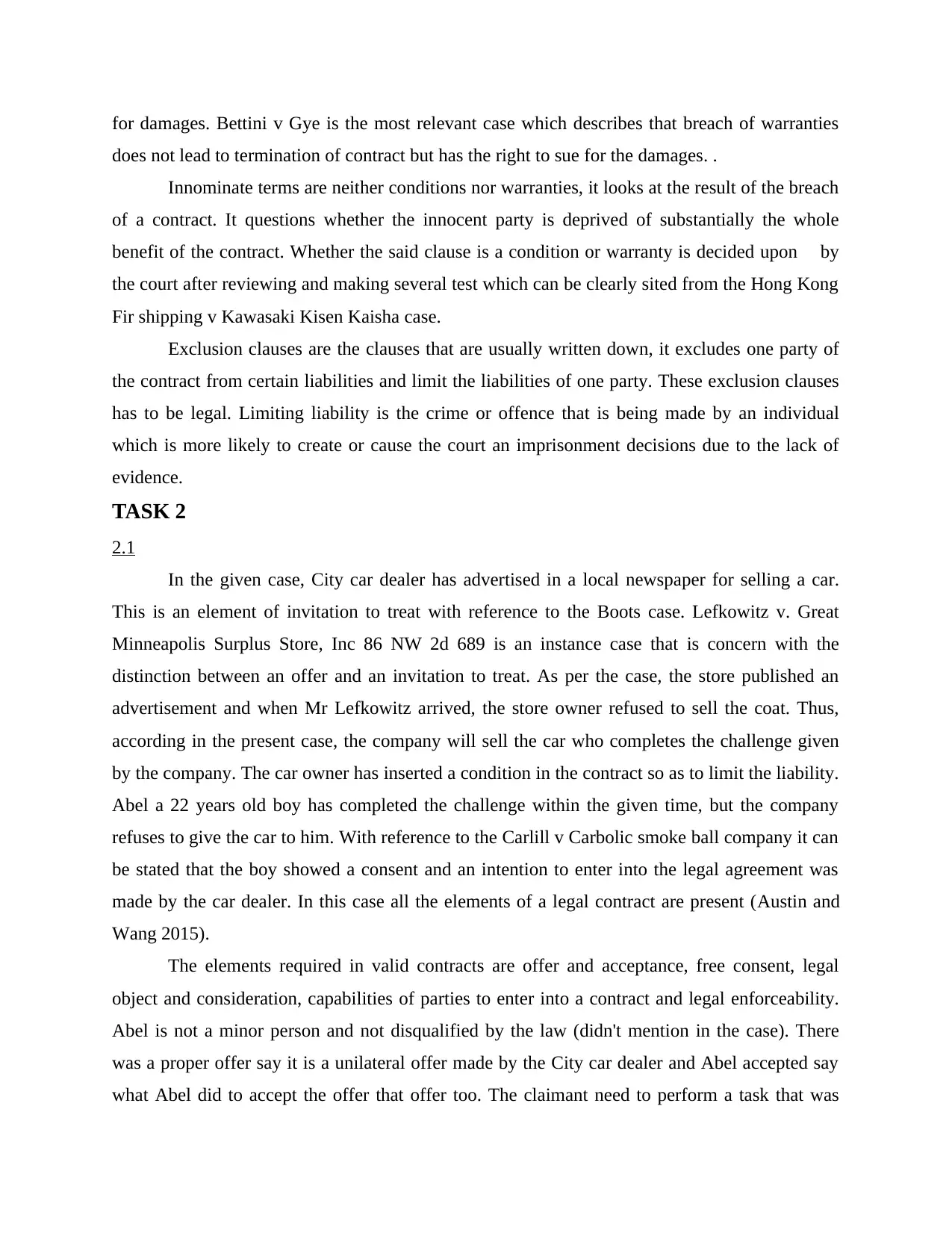
for damages. Bettini v Gye is the most relevant case which describes that breach of warranties
does not lead to termination of contract but has the right to sue for the damages. .
Innominate terms are neither conditions nor warranties, it looks at the result of the breach
of a contract. It questions whether the innocent party is deprived of substantially the whole
benefit of the contract. Whether the said clause is a condition or warranty is decided upon by
the court after reviewing and making several test which can be clearly sited from the Hong Kong
Fir shipping v Kawasaki Kisen Kaisha case.
Exclusion clauses are the clauses that are usually written down, it excludes one party of
the contract from certain liabilities and limit the liabilities of one party. These exclusion clauses
has to be legal. Limiting liability is the crime or offence that is being made by an individual
which is more likely to create or cause the court an imprisonment decisions due to the lack of
evidence.
TASK 2
2.1
In the given case, City car dealer has advertised in a local newspaper for selling a car.
This is an element of invitation to treat with reference to the Boots case. Lefkowitz v. Great
Minneapolis Surplus Store, Inc 86 NW 2d 689 is an instance case that is concern with the
distinction between an offer and an invitation to treat. As per the case, the store published an
advertisement and when Mr Lefkowitz arrived, the store owner refused to sell the coat. Thus,
according in the present case, the company will sell the car who completes the challenge given
by the company. The car owner has inserted a condition in the contract so as to limit the liability.
Abel a 22 years old boy has completed the challenge within the given time, but the company
refuses to give the car to him. With reference to the Carlill v Carbolic smoke ball company it can
be stated that the boy showed a consent and an intention to enter into the legal agreement was
made by the car dealer. In this case all the elements of a legal contract are present (Austin and
Wang 2015).
The elements required in valid contracts are offer and acceptance, free consent, legal
object and consideration, capabilities of parties to enter into a contract and legal enforceability.
Abel is not a minor person and not disqualified by the law (didn't mention in the case). There
was a proper offer say it is a unilateral offer made by the City car dealer and Abel accepted say
what Abel did to accept the offer that offer too. The claimant need to perform a task that was
does not lead to termination of contract but has the right to sue for the damages. .
Innominate terms are neither conditions nor warranties, it looks at the result of the breach
of a contract. It questions whether the innocent party is deprived of substantially the whole
benefit of the contract. Whether the said clause is a condition or warranty is decided upon by
the court after reviewing and making several test which can be clearly sited from the Hong Kong
Fir shipping v Kawasaki Kisen Kaisha case.
Exclusion clauses are the clauses that are usually written down, it excludes one party of
the contract from certain liabilities and limit the liabilities of one party. These exclusion clauses
has to be legal. Limiting liability is the crime or offence that is being made by an individual
which is more likely to create or cause the court an imprisonment decisions due to the lack of
evidence.
TASK 2
2.1
In the given case, City car dealer has advertised in a local newspaper for selling a car.
This is an element of invitation to treat with reference to the Boots case. Lefkowitz v. Great
Minneapolis Surplus Store, Inc 86 NW 2d 689 is an instance case that is concern with the
distinction between an offer and an invitation to treat. As per the case, the store published an
advertisement and when Mr Lefkowitz arrived, the store owner refused to sell the coat. Thus,
according in the present case, the company will sell the car who completes the challenge given
by the company. The car owner has inserted a condition in the contract so as to limit the liability.
Abel a 22 years old boy has completed the challenge within the given time, but the company
refuses to give the car to him. With reference to the Carlill v Carbolic smoke ball company it can
be stated that the boy showed a consent and an intention to enter into the legal agreement was
made by the car dealer. In this case all the elements of a legal contract are present (Austin and
Wang 2015).
The elements required in valid contracts are offer and acceptance, free consent, legal
object and consideration, capabilities of parties to enter into a contract and legal enforceability.
Abel is not a minor person and not disqualified by the law (didn't mention in the case). There
was a proper offer say it is a unilateral offer made by the City car dealer and Abel accepted say
what Abel did to accept the offer that offer too. The claimant need to perform a task that was
⊘ This is a preview!⊘
Do you want full access?
Subscribe today to unlock all pages.

Trusted by 1+ million students worldwide
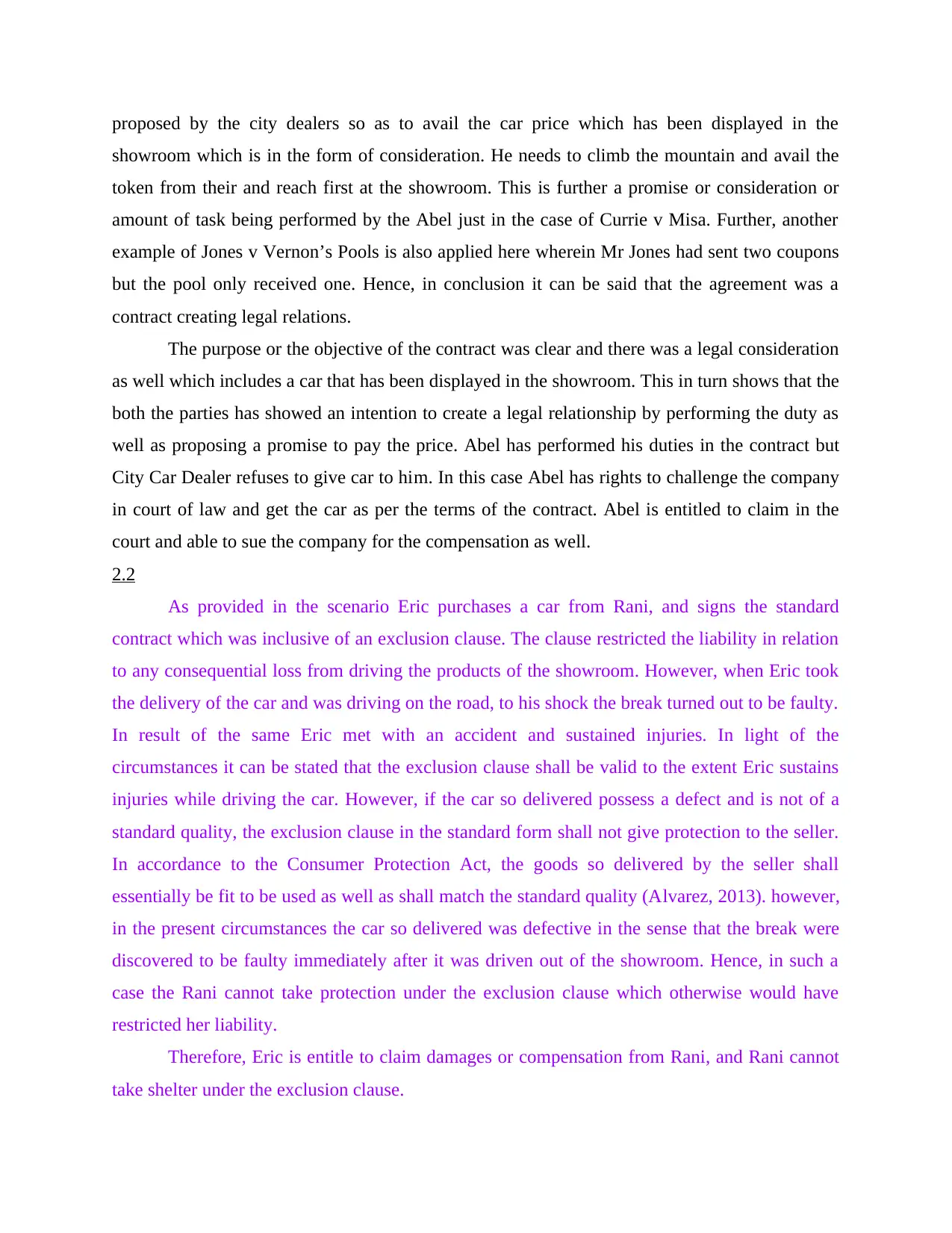
proposed by the city dealers so as to avail the car price which has been displayed in the
showroom which is in the form of consideration. He needs to climb the mountain and avail the
token from their and reach first at the showroom. This is further a promise or consideration or
amount of task being performed by the Abel just in the case of Currie v Misa. Further, another
example of Jones v Vernon’s Pools is also applied here wherein Mr Jones had sent two coupons
but the pool only received one. Hence, in conclusion it can be said that the agreement was a
contract creating legal relations.
The purpose or the objective of the contract was clear and there was a legal consideration
as well which includes a car that has been displayed in the showroom. This in turn shows that the
both the parties has showed an intention to create a legal relationship by performing the duty as
well as proposing a promise to pay the price. Abel has performed his duties in the contract but
City Car Dealer refuses to give car to him. In this case Abel has rights to challenge the company
in court of law and get the car as per the terms of the contract. Abel is entitled to claim in the
court and able to sue the company for the compensation as well.
2.2
As provided in the scenario Eric purchases a car from Rani, and signs the standard
contract which was inclusive of an exclusion clause. The clause restricted the liability in relation
to any consequential loss from driving the products of the showroom. However, when Eric took
the delivery of the car and was driving on the road, to his shock the break turned out to be faulty.
In result of the same Eric met with an accident and sustained injuries. In light of the
circumstances it can be stated that the exclusion clause shall be valid to the extent Eric sustains
injuries while driving the car. However, if the car so delivered possess a defect and is not of a
standard quality, the exclusion clause in the standard form shall not give protection to the seller.
In accordance to the Consumer Protection Act, the goods so delivered by the seller shall
essentially be fit to be used as well as shall match the standard quality (Alvarez, 2013). however,
in the present circumstances the car so delivered was defective in the sense that the break were
discovered to be faulty immediately after it was driven out of the showroom. Hence, in such a
case the Rani cannot take protection under the exclusion clause which otherwise would have
restricted her liability.
Therefore, Eric is entitle to claim damages or compensation from Rani, and Rani cannot
take shelter under the exclusion clause.
showroom which is in the form of consideration. He needs to climb the mountain and avail the
token from their and reach first at the showroom. This is further a promise or consideration or
amount of task being performed by the Abel just in the case of Currie v Misa. Further, another
example of Jones v Vernon’s Pools is also applied here wherein Mr Jones had sent two coupons
but the pool only received one. Hence, in conclusion it can be said that the agreement was a
contract creating legal relations.
The purpose or the objective of the contract was clear and there was a legal consideration
as well which includes a car that has been displayed in the showroom. This in turn shows that the
both the parties has showed an intention to create a legal relationship by performing the duty as
well as proposing a promise to pay the price. Abel has performed his duties in the contract but
City Car Dealer refuses to give car to him. In this case Abel has rights to challenge the company
in court of law and get the car as per the terms of the contract. Abel is entitled to claim in the
court and able to sue the company for the compensation as well.
2.2
As provided in the scenario Eric purchases a car from Rani, and signs the standard
contract which was inclusive of an exclusion clause. The clause restricted the liability in relation
to any consequential loss from driving the products of the showroom. However, when Eric took
the delivery of the car and was driving on the road, to his shock the break turned out to be faulty.
In result of the same Eric met with an accident and sustained injuries. In light of the
circumstances it can be stated that the exclusion clause shall be valid to the extent Eric sustains
injuries while driving the car. However, if the car so delivered possess a defect and is not of a
standard quality, the exclusion clause in the standard form shall not give protection to the seller.
In accordance to the Consumer Protection Act, the goods so delivered by the seller shall
essentially be fit to be used as well as shall match the standard quality (Alvarez, 2013). however,
in the present circumstances the car so delivered was defective in the sense that the break were
discovered to be faulty immediately after it was driven out of the showroom. Hence, in such a
case the Rani cannot take protection under the exclusion clause which otherwise would have
restricted her liability.
Therefore, Eric is entitle to claim damages or compensation from Rani, and Rani cannot
take shelter under the exclusion clause.
Paraphrase This Document
Need a fresh take? Get an instant paraphrase of this document with our AI Paraphraser
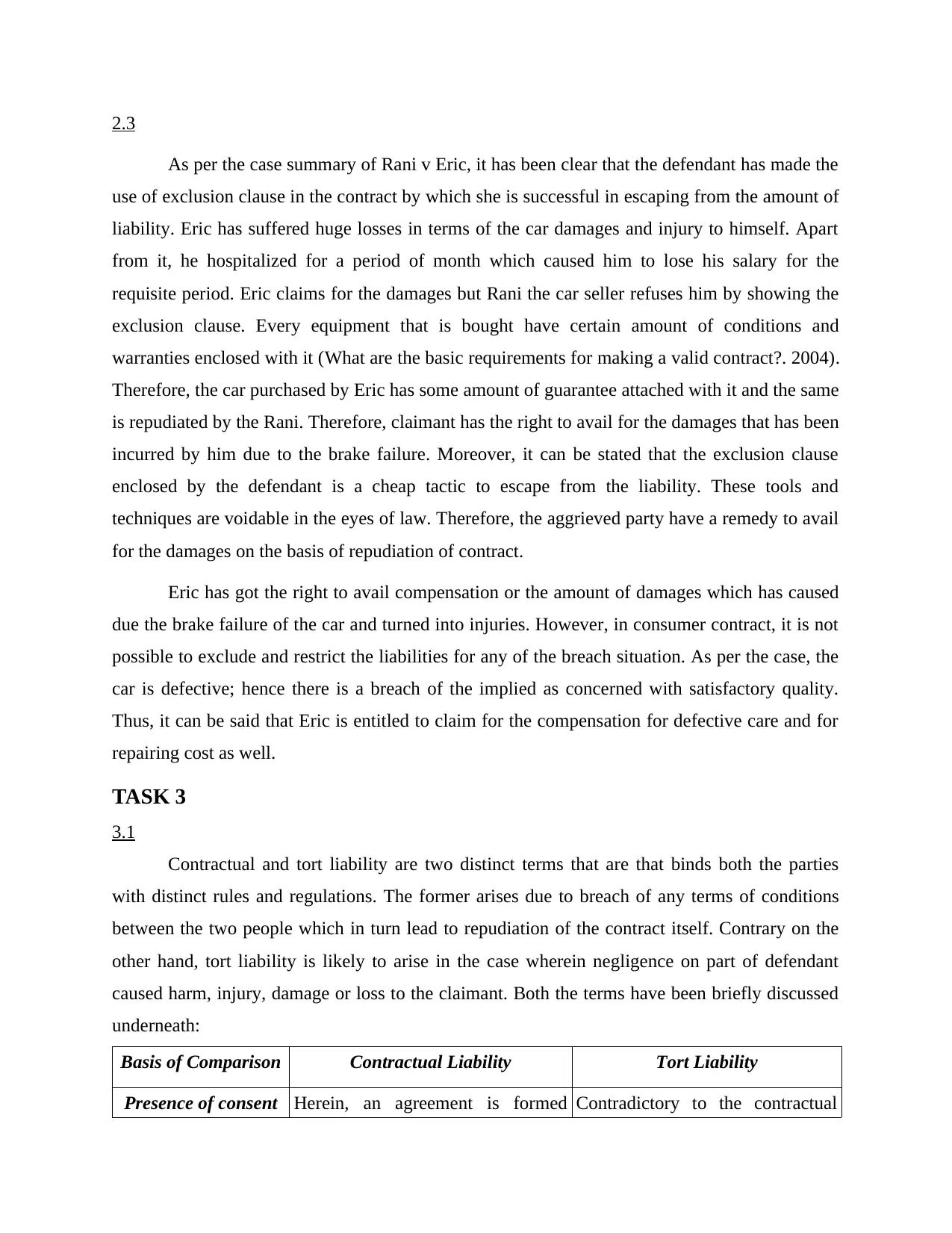
2.3
As per the case summary of Rani v Eric, it has been clear that the defendant has made the
use of exclusion clause in the contract by which she is successful in escaping from the amount of
liability. Eric has suffered huge losses in terms of the car damages and injury to himself. Apart
from it, he hospitalized for a period of month which caused him to lose his salary for the
requisite period. Eric claims for the damages but Rani the car seller refuses him by showing the
exclusion clause. Every equipment that is bought have certain amount of conditions and
warranties enclosed with it (What are the basic requirements for making a valid contract?. 2004).
Therefore, the car purchased by Eric has some amount of guarantee attached with it and the same
is repudiated by the Rani. Therefore, claimant has the right to avail for the damages that has been
incurred by him due to the brake failure. Moreover, it can be stated that the exclusion clause
enclosed by the defendant is a cheap tactic to escape from the liability. These tools and
techniques are voidable in the eyes of law. Therefore, the aggrieved party have a remedy to avail
for the damages on the basis of repudiation of contract.
Eric has got the right to avail compensation or the amount of damages which has caused
due the brake failure of the car and turned into injuries. However, in consumer contract, it is not
possible to exclude and restrict the liabilities for any of the breach situation. As per the case, the
car is defective; hence there is a breach of the implied as concerned with satisfactory quality.
Thus, it can be said that Eric is entitled to claim for the compensation for defective care and for
repairing cost as well.
TASK 3
3.1
Contractual and tort liability are two distinct terms that are that binds both the parties
with distinct rules and regulations. The former arises due to breach of any terms of conditions
between the two people which in turn lead to repudiation of the contract itself. Contrary on the
other hand, tort liability is likely to arise in the case wherein negligence on part of defendant
caused harm, injury, damage or loss to the claimant. Both the terms have been briefly discussed
underneath:
Basis of Comparison Contractual Liability Tort Liability
Presence of consent Herein, an agreement is formed Contradictory to the contractual
As per the case summary of Rani v Eric, it has been clear that the defendant has made the
use of exclusion clause in the contract by which she is successful in escaping from the amount of
liability. Eric has suffered huge losses in terms of the car damages and injury to himself. Apart
from it, he hospitalized for a period of month which caused him to lose his salary for the
requisite period. Eric claims for the damages but Rani the car seller refuses him by showing the
exclusion clause. Every equipment that is bought have certain amount of conditions and
warranties enclosed with it (What are the basic requirements for making a valid contract?. 2004).
Therefore, the car purchased by Eric has some amount of guarantee attached with it and the same
is repudiated by the Rani. Therefore, claimant has the right to avail for the damages that has been
incurred by him due to the brake failure. Moreover, it can be stated that the exclusion clause
enclosed by the defendant is a cheap tactic to escape from the liability. These tools and
techniques are voidable in the eyes of law. Therefore, the aggrieved party have a remedy to avail
for the damages on the basis of repudiation of contract.
Eric has got the right to avail compensation or the amount of damages which has caused
due the brake failure of the car and turned into injuries. However, in consumer contract, it is not
possible to exclude and restrict the liabilities for any of the breach situation. As per the case, the
car is defective; hence there is a breach of the implied as concerned with satisfactory quality.
Thus, it can be said that Eric is entitled to claim for the compensation for defective care and for
repairing cost as well.
TASK 3
3.1
Contractual and tort liability are two distinct terms that are that binds both the parties
with distinct rules and regulations. The former arises due to breach of any terms of conditions
between the two people which in turn lead to repudiation of the contract itself. Contrary on the
other hand, tort liability is likely to arise in the case wherein negligence on part of defendant
caused harm, injury, damage or loss to the claimant. Both the terms have been briefly discussed
underneath:
Basis of Comparison Contractual Liability Tort Liability
Presence of consent Herein, an agreement is formed Contradictory to the contractual
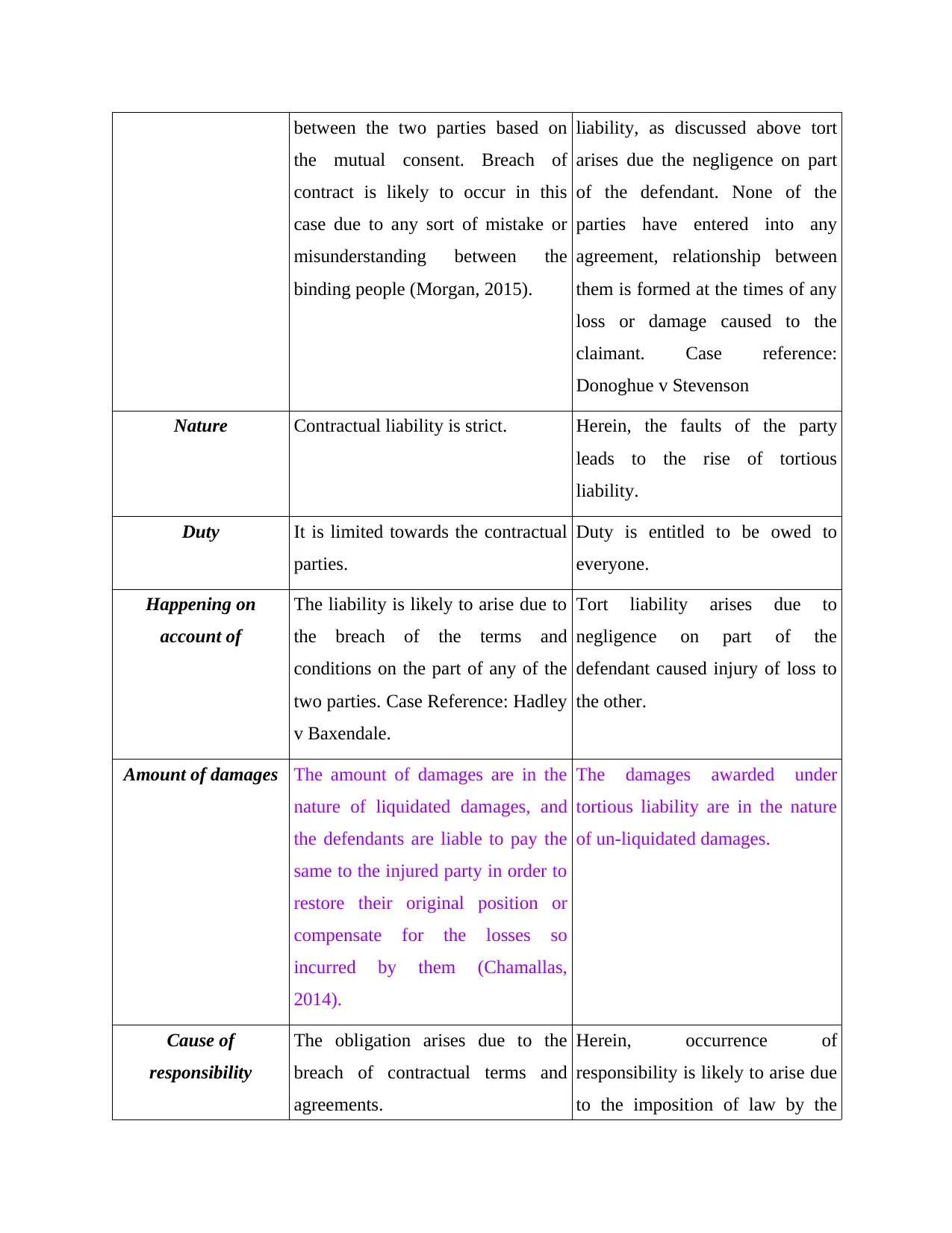
between the two parties based on
the mutual consent. Breach of
contract is likely to occur in this
case due to any sort of mistake or
misunderstanding between the
binding people (Morgan, 2015).
liability, as discussed above tort
arises due the negligence on part
of the defendant. None of the
parties have entered into any
agreement, relationship between
them is formed at the times of any
loss or damage caused to the
claimant. Case reference:
Donoghue v Stevenson
Nature Contractual liability is strict. Herein, the faults of the party
leads to the rise of tortious
liability.
Duty It is limited towards the contractual
parties.
Duty is entitled to be owed to
everyone.
Happening on
account of
The liability is likely to arise due to
the breach of the terms and
conditions on the part of any of the
two parties. Case Reference: Hadley
v Baxendale.
Tort liability arises due to
negligence on part of the
defendant caused injury of loss to
the other.
Amount of damages The amount of damages are in the
nature of liquidated damages, and
the defendants are liable to pay the
same to the injured party in order to
restore their original position or
compensate for the losses so
incurred by them (Chamallas,
2014).
The damages awarded under
tortious liability are in the nature
of un-liquidated damages.
Cause of
responsibility
The obligation arises due to the
breach of contractual terms and
agreements.
Herein, occurrence of
responsibility is likely to arise due
to the imposition of law by the
the mutual consent. Breach of
contract is likely to occur in this
case due to any sort of mistake or
misunderstanding between the
binding people (Morgan, 2015).
liability, as discussed above tort
arises due the negligence on part
of the defendant. None of the
parties have entered into any
agreement, relationship between
them is formed at the times of any
loss or damage caused to the
claimant. Case reference:
Donoghue v Stevenson
Nature Contractual liability is strict. Herein, the faults of the party
leads to the rise of tortious
liability.
Duty It is limited towards the contractual
parties.
Duty is entitled to be owed to
everyone.
Happening on
account of
The liability is likely to arise due to
the breach of the terms and
conditions on the part of any of the
two parties. Case Reference: Hadley
v Baxendale.
Tort liability arises due to
negligence on part of the
defendant caused injury of loss to
the other.
Amount of damages The amount of damages are in the
nature of liquidated damages, and
the defendants are liable to pay the
same to the injured party in order to
restore their original position or
compensate for the losses so
incurred by them (Chamallas,
2014).
The damages awarded under
tortious liability are in the nature
of un-liquidated damages.
Cause of
responsibility
The obligation arises due to the
breach of contractual terms and
agreements.
Herein, occurrence of
responsibility is likely to arise due
to the imposition of law by the
⊘ This is a preview!⊘
Do you want full access?
Subscribe today to unlock all pages.

Trusted by 1+ million students worldwide
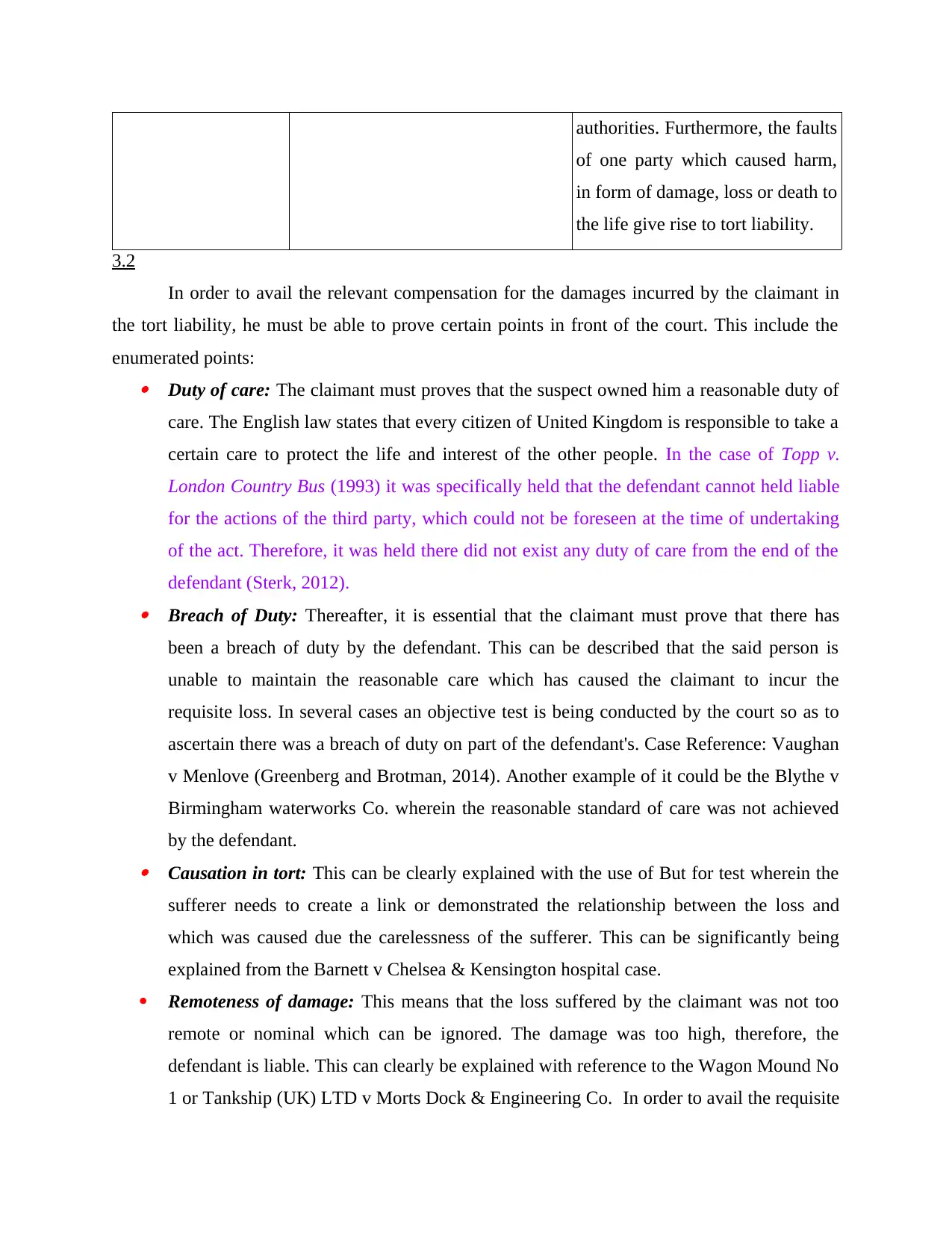
authorities. Furthermore, the faults
of one party which caused harm,
in form of damage, loss or death to
the life give rise to tort liability.
3.2
In order to avail the relevant compensation for the damages incurred by the claimant in
the tort liability, he must be able to prove certain points in front of the court. This include the
enumerated points: Duty of care: The claimant must proves that the suspect owned him a reasonable duty of
care. The English law states that every citizen of United Kingdom is responsible to take a
certain care to protect the life and interest of the other people. In the case of Topp v.
London Country Bus (1993) it was specifically held that the defendant cannot held liable
for the actions of the third party, which could not be foreseen at the time of undertaking
of the act. Therefore, it was held there did not exist any duty of care from the end of the
defendant (Sterk, 2012). Breach of Duty: Thereafter, it is essential that the claimant must prove that there has
been a breach of duty by the defendant. This can be described that the said person is
unable to maintain the reasonable care which has caused the claimant to incur the
requisite loss. In several cases an objective test is being conducted by the court so as to
ascertain there was a breach of duty on part of the defendant's. Case Reference: Vaughan
v Menlove (Greenberg and Brotman, 2014). Another example of it could be the Blythe v
Birmingham waterworks Co. wherein the reasonable standard of care was not achieved
by the defendant. Causation in tort: This can be clearly explained with the use of But for test wherein the
sufferer needs to create a link or demonstrated the relationship between the loss and
which was caused due the carelessness of the sufferer. This can be significantly being
explained from the Barnett v Chelsea & Kensington hospital case.
Remoteness of damage: This means that the loss suffered by the claimant was not too
remote or nominal which can be ignored. The damage was too high, therefore, the
defendant is liable. This can clearly be explained with reference to the Wagon Mound No
1 or Tankship (UK) LTD v Morts Dock & Engineering Co. In order to avail the requisite
of one party which caused harm,
in form of damage, loss or death to
the life give rise to tort liability.
3.2
In order to avail the relevant compensation for the damages incurred by the claimant in
the tort liability, he must be able to prove certain points in front of the court. This include the
enumerated points: Duty of care: The claimant must proves that the suspect owned him a reasonable duty of
care. The English law states that every citizen of United Kingdom is responsible to take a
certain care to protect the life and interest of the other people. In the case of Topp v.
London Country Bus (1993) it was specifically held that the defendant cannot held liable
for the actions of the third party, which could not be foreseen at the time of undertaking
of the act. Therefore, it was held there did not exist any duty of care from the end of the
defendant (Sterk, 2012). Breach of Duty: Thereafter, it is essential that the claimant must prove that there has
been a breach of duty by the defendant. This can be described that the said person is
unable to maintain the reasonable care which has caused the claimant to incur the
requisite loss. In several cases an objective test is being conducted by the court so as to
ascertain there was a breach of duty on part of the defendant's. Case Reference: Vaughan
v Menlove (Greenberg and Brotman, 2014). Another example of it could be the Blythe v
Birmingham waterworks Co. wherein the reasonable standard of care was not achieved
by the defendant. Causation in tort: This can be clearly explained with the use of But for test wherein the
sufferer needs to create a link or demonstrated the relationship between the loss and
which was caused due the carelessness of the sufferer. This can be significantly being
explained from the Barnett v Chelsea & Kensington hospital case.
Remoteness of damage: This means that the loss suffered by the claimant was not too
remote or nominal which can be ignored. The damage was too high, therefore, the
defendant is liable. This can clearly be explained with reference to the Wagon Mound No
1 or Tankship (UK) LTD v Morts Dock & Engineering Co. In order to avail the requisite
Paraphrase This Document
Need a fresh take? Get an instant paraphrase of this document with our AI Paraphraser
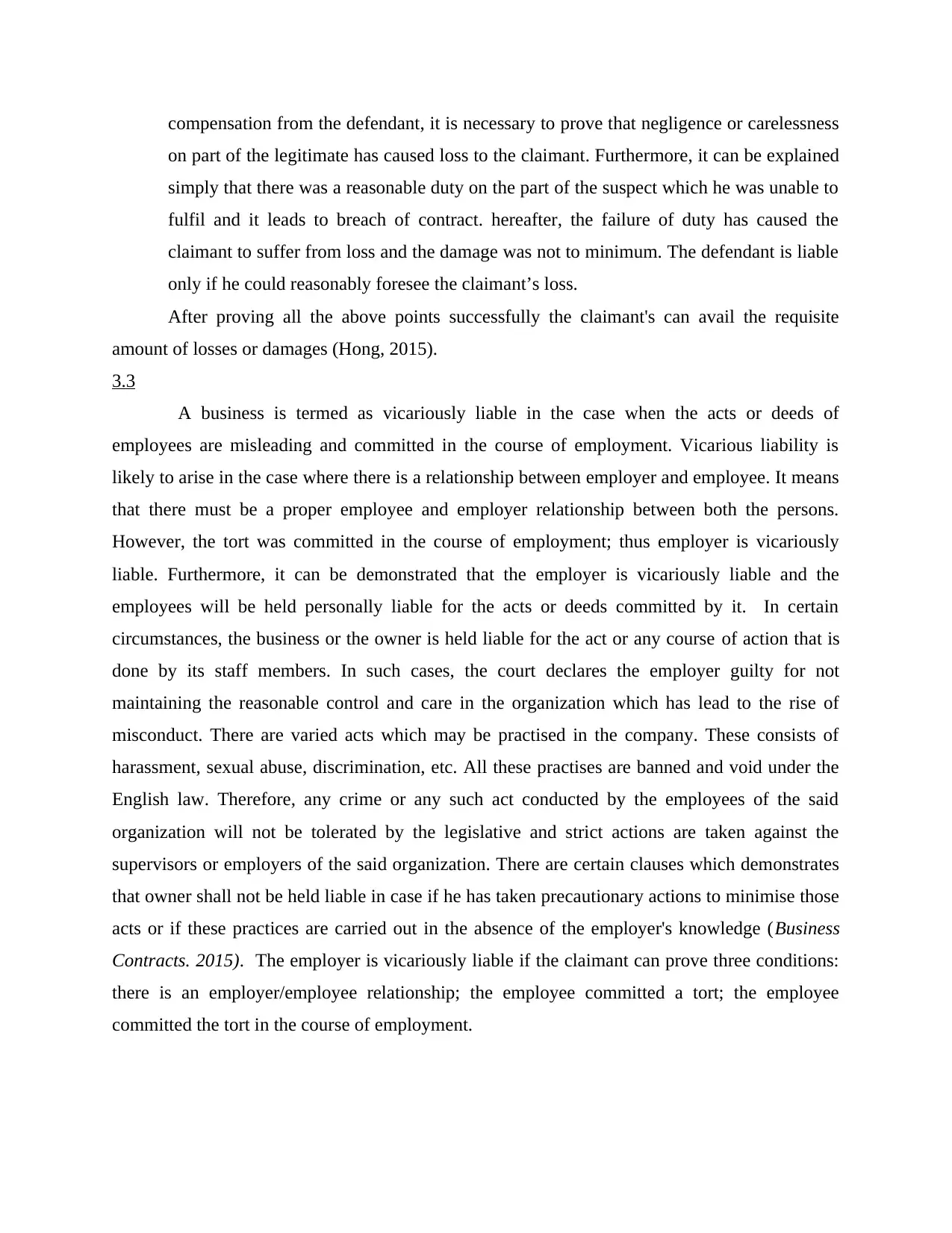
compensation from the defendant, it is necessary to prove that negligence or carelessness
on part of the legitimate has caused loss to the claimant. Furthermore, it can be explained
simply that there was a reasonable duty on the part of the suspect which he was unable to
fulfil and it leads to breach of contract. hereafter, the failure of duty has caused the
claimant to suffer from loss and the damage was not to minimum. The defendant is liable
only if he could reasonably foresee the claimant’s loss.
After proving all the above points successfully the claimant's can avail the requisite
amount of losses or damages (Hong, 2015).
3.3
A business is termed as vicariously liable in the case when the acts or deeds of
employees are misleading and committed in the course of employment. Vicarious liability is
likely to arise in the case where there is a relationship between employer and employee. It means
that there must be a proper employee and employer relationship between both the persons.
However, the tort was committed in the course of employment; thus employer is vicariously
liable. Furthermore, it can be demonstrated that the employer is vicariously liable and the
employees will be held personally liable for the acts or deeds committed by it. In certain
circumstances, the business or the owner is held liable for the act or any course of action that is
done by its staff members. In such cases, the court declares the employer guilty for not
maintaining the reasonable control and care in the organization which has lead to the rise of
misconduct. There are varied acts which may be practised in the company. These consists of
harassment, sexual abuse, discrimination, etc. All these practises are banned and void under the
English law. Therefore, any crime or any such act conducted by the employees of the said
organization will not be tolerated by the legislative and strict actions are taken against the
supervisors or employers of the said organization. There are certain clauses which demonstrates
that owner shall not be held liable in case if he has taken precautionary actions to minimise those
acts or if these practices are carried out in the absence of the employer's knowledge (Business
Contracts. 2015). The employer is vicariously liable if the claimant can prove three conditions:
there is an employer/employee relationship; the employee committed a tort; the employee
committed the tort in the course of employment.
on part of the legitimate has caused loss to the claimant. Furthermore, it can be explained
simply that there was a reasonable duty on the part of the suspect which he was unable to
fulfil and it leads to breach of contract. hereafter, the failure of duty has caused the
claimant to suffer from loss and the damage was not to minimum. The defendant is liable
only if he could reasonably foresee the claimant’s loss.
After proving all the above points successfully the claimant's can avail the requisite
amount of losses or damages (Hong, 2015).
3.3
A business is termed as vicariously liable in the case when the acts or deeds of
employees are misleading and committed in the course of employment. Vicarious liability is
likely to arise in the case where there is a relationship between employer and employee. It means
that there must be a proper employee and employer relationship between both the persons.
However, the tort was committed in the course of employment; thus employer is vicariously
liable. Furthermore, it can be demonstrated that the employer is vicariously liable and the
employees will be held personally liable for the acts or deeds committed by it. In certain
circumstances, the business or the owner is held liable for the act or any course of action that is
done by its staff members. In such cases, the court declares the employer guilty for not
maintaining the reasonable control and care in the organization which has lead to the rise of
misconduct. There are varied acts which may be practised in the company. These consists of
harassment, sexual abuse, discrimination, etc. All these practises are banned and void under the
English law. Therefore, any crime or any such act conducted by the employees of the said
organization will not be tolerated by the legislative and strict actions are taken against the
supervisors or employers of the said organization. There are certain clauses which demonstrates
that owner shall not be held liable in case if he has taken precautionary actions to minimise those
acts or if these practices are carried out in the absence of the employer's knowledge (Business
Contracts. 2015). The employer is vicariously liable if the claimant can prove three conditions:
there is an employer/employee relationship; the employee committed a tort; the employee
committed the tort in the course of employment.
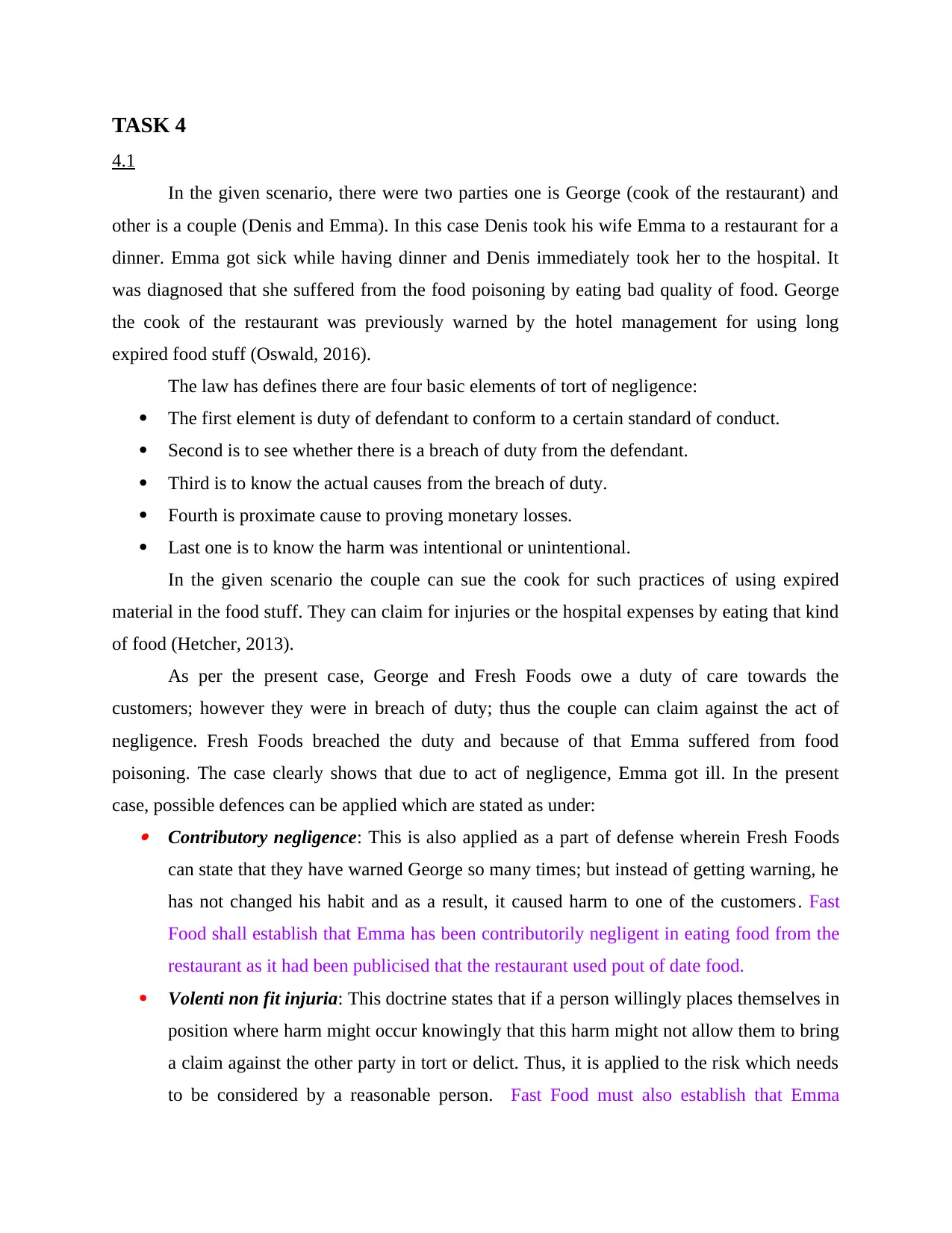
TASK 4
4.1
In the given scenario, there were two parties one is George (cook of the restaurant) and
other is a couple (Denis and Emma). In this case Denis took his wife Emma to a restaurant for a
dinner. Emma got sick while having dinner and Denis immediately took her to the hospital. It
was diagnosed that she suffered from the food poisoning by eating bad quality of food. George
the cook of the restaurant was previously warned by the hotel management for using long
expired food stuff (Oswald, 2016).
The law has defines there are four basic elements of tort of negligence:
The first element is duty of defendant to conform to a certain standard of conduct.
Second is to see whether there is a breach of duty from the defendant.
Third is to know the actual causes from the breach of duty.
Fourth is proximate cause to proving monetary losses.
Last one is to know the harm was intentional or unintentional.
In the given scenario the couple can sue the cook for such practices of using expired
material in the food stuff. They can claim for injuries or the hospital expenses by eating that kind
of food (Hetcher, 2013).
As per the present case, George and Fresh Foods owe a duty of care towards the
customers; however they were in breach of duty; thus the couple can claim against the act of
negligence. Fresh Foods breached the duty and because of that Emma suffered from food
poisoning. The case clearly shows that due to act of negligence, Emma got ill. In the present
case, possible defences can be applied which are stated as under: Contributory negligence: This is also applied as a part of defense wherein Fresh Foods
can state that they have warned George so many times; but instead of getting warning, he
has not changed his habit and as a result, it caused harm to one of the customers. Fast
Food shall establish that Emma has been contributorily negligent in eating food from the
restaurant as it had been publicised that the restaurant used pout of date food.
Volenti non fit injuria: This doctrine states that if a person willingly places themselves in
position where harm might occur knowingly that this harm might not allow them to bring
a claim against the other party in tort or delict. Thus, it is applied to the risk which needs
to be considered by a reasonable person. Fast Food must also establish that Emma
4.1
In the given scenario, there were two parties one is George (cook of the restaurant) and
other is a couple (Denis and Emma). In this case Denis took his wife Emma to a restaurant for a
dinner. Emma got sick while having dinner and Denis immediately took her to the hospital. It
was diagnosed that she suffered from the food poisoning by eating bad quality of food. George
the cook of the restaurant was previously warned by the hotel management for using long
expired food stuff (Oswald, 2016).
The law has defines there are four basic elements of tort of negligence:
The first element is duty of defendant to conform to a certain standard of conduct.
Second is to see whether there is a breach of duty from the defendant.
Third is to know the actual causes from the breach of duty.
Fourth is proximate cause to proving monetary losses.
Last one is to know the harm was intentional or unintentional.
In the given scenario the couple can sue the cook for such practices of using expired
material in the food stuff. They can claim for injuries or the hospital expenses by eating that kind
of food (Hetcher, 2013).
As per the present case, George and Fresh Foods owe a duty of care towards the
customers; however they were in breach of duty; thus the couple can claim against the act of
negligence. Fresh Foods breached the duty and because of that Emma suffered from food
poisoning. The case clearly shows that due to act of negligence, Emma got ill. In the present
case, possible defences can be applied which are stated as under: Contributory negligence: This is also applied as a part of defense wherein Fresh Foods
can state that they have warned George so many times; but instead of getting warning, he
has not changed his habit and as a result, it caused harm to one of the customers. Fast
Food shall establish that Emma has been contributorily negligent in eating food from the
restaurant as it had been publicised that the restaurant used pout of date food.
Volenti non fit injuria: This doctrine states that if a person willingly places themselves in
position where harm might occur knowingly that this harm might not allow them to bring
a claim against the other party in tort or delict. Thus, it is applied to the risk which needs
to be considered by a reasonable person. Fast Food must also establish that Emma
⊘ This is a preview!⊘
Do you want full access?
Subscribe today to unlock all pages.

Trusted by 1+ million students worldwide
1 out of 17
Related Documents
Your All-in-One AI-Powered Toolkit for Academic Success.
+13062052269
info@desklib.com
Available 24*7 on WhatsApp / Email
![[object Object]](/_next/static/media/star-bottom.7253800d.svg)
Unlock your academic potential
Copyright © 2020–2025 A2Z Services. All Rights Reserved. Developed and managed by ZUCOL.





